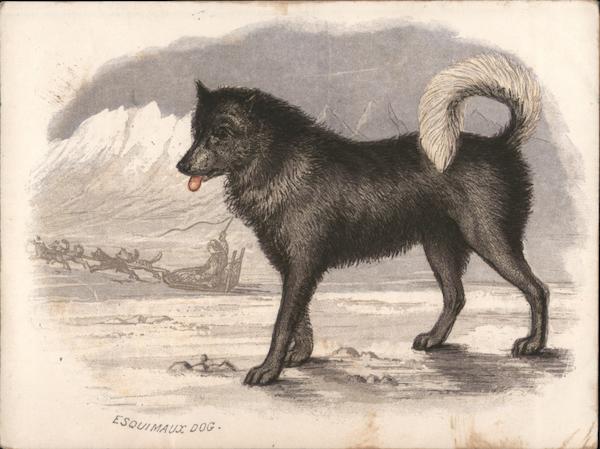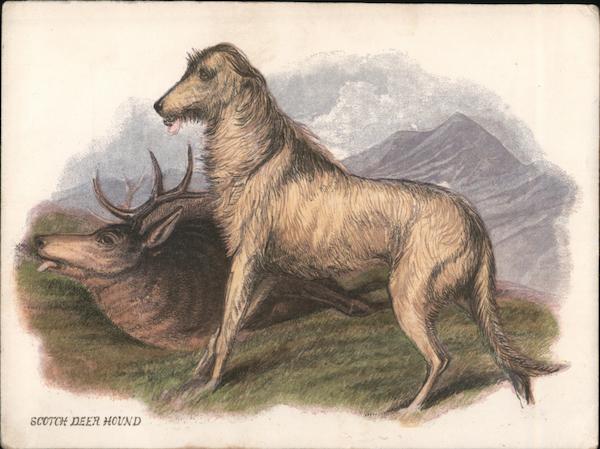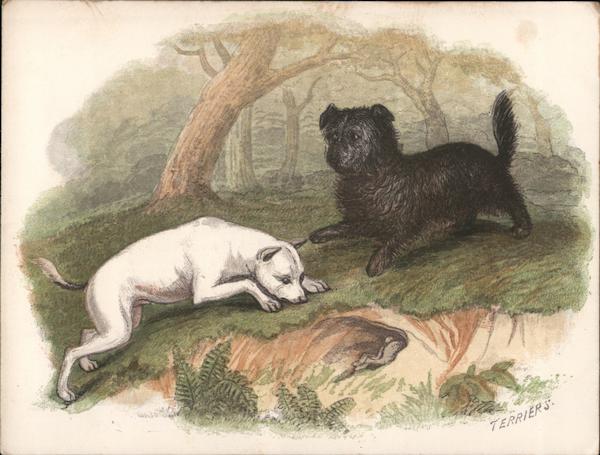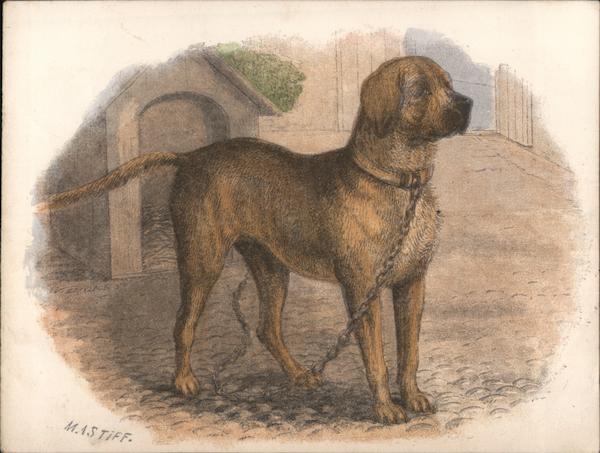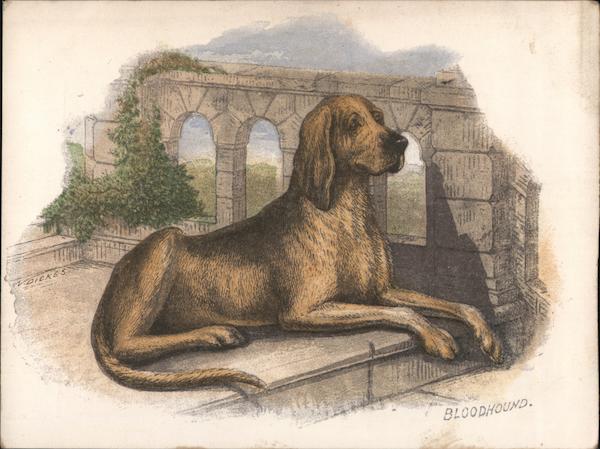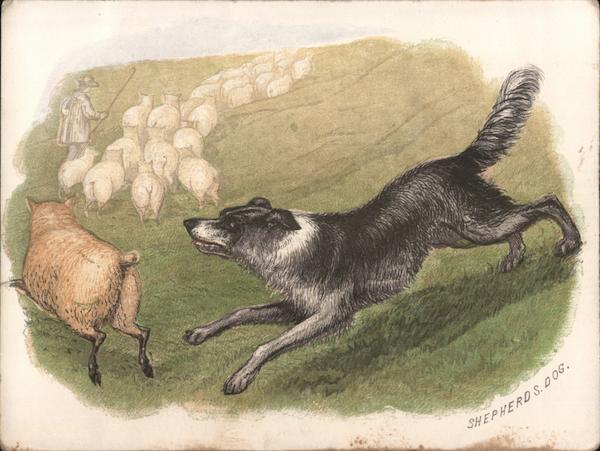Set of 7: Dogs
Front:
ESQUIMAUX DOG.
SCOTCH DEER HOUND
MOUNT. ST. BERNARD
DOG,
TERRIERS
CHES
MASTIFF
VDICKES
BLOODHOUND.
SHEPHERD S. DOG.
Back:
THE ESQUIMAUX DOG.
"But learn we might, if not too proud to stoop
To quadruped instructors, many a good
And useful quality, and virtue too,
Rarely exemplified among ourselves,
Attachment never to be weaned or changed
By any change of fortune, proof alike
Against unkindness, absence and neglect,
Fidelity that neither bribe nor threat
Can move or warp; and gratitude for small
And trivial favours lasting as the life,
And glistening even in the dying eye."
COWPER.
In the extreme north of America, among mountains of ice and frozen seas.
live a tribe of white Indians called Esquimaux. They are a wild, uncivi-
lized race, who pass their lives in hunting the bear, the seal, and the deer,
while they live upon the flesh of these animals and wear their skins. These
Esquimaux possess a very fine race of dogs, on which they are dependent
for most of the comforts of their lives. These dogs assist them in tracking
and killing their game, and in drawing them in sledges over the frozen
plains in pursuit of it. They are about the same height as the Newfound-
land dog, but broader and stronger. They are sometimes of a gray colour,
sometimes black and white, with a rough, bushy tail; and their pointed ears
and sharp nose give them a strong resemblance to the wolf, to which animal
they are supposed to be nearly allied. Though half starved, cruelly treated,
and often worked to death by their masters, they return good for evil, and
are faithful and good-tempered, and even attached to them; so much so,
that though turned away to shift for themselves during the summer, they
never fail to return each to his own master when it is over.
From six to twelve dogs are harnessed to a sledge, each by a single trace,
and without reins, so that they are guided entirely by the whip or by the
voice of the driver. Each dog can draw a weight of a hundred and twenty
pounds over the snow, and often travels sixty miles a day. If going home-
wards, or towards any place which they have been accustomed to visit,
they may be trusted to find the way across trackless plains of snow; but if
they scent a deer or a bear, off they gallop in pursuit of it, and when near
enough, attack it, and assist their masters in destroying it. If they are
killed in these encounters, or by the hardships and privations which they
have to undergo, they are devoured by their hungry companions, or some-
times even by their masters, and their skins are converted into warm clothing.
In the different searches which have been made for Sir John Franklin and
his party, these dogs were employed, and were found of inestimable value;
and when the remains of these unfortunate men and their ships were at
last found by Capt. M'Clintock, it was not till he had travelled for many
weeks over the ice and snow in sledges drawn by these dogs.
THE GREYHOUND.
"As when the impatient greyhound slipped from far
Bounds o'er the glade to course the tearful hare,
She in her speed does all her safety lay,
And he with double speed pursues the prey."
THE most graceful and the fleetest of all dogs is the greyhound. Even
from the time of the ancient Greeks and Romans he has been used to hunt
the hare and other game, and mention is made of him in the very early
history of Britain. He has always been the favourite of kings and nobles.
Henry II. was very fond of greyhounds, and the Isle of Dogs, on the
Thames, opposite Greenwich, was so called from its having been the place
where King John kept his greyhounds and spaniels; and it was to Prince
Llewellyn, son-in-law to King John, that the faithful dog Gelert belonged,
whose sad story is told in the famous poem called Beth Gelert. We read in
the poem that "The gallant hound a v'olf had slain to save Llewellyn's
heir," so that in those days the greyhound probably resembled the Scotch
deerhound, and must have been a larger and fiercer dog than he is now. But
as there are happily no wolves to be slain in England now-a-days, speed is
more valued in greyhound than strength, and it is said that he can run
as fast as the fleetest horse, and has been even known to run eight miles
in twelve minutes in pursuit of a hare. The English greyhound follows the
hare by sight and not by scent. He has a smooth, glossy coat, and is
either white, black, brindled, or fawn-coloured, and has a very long, narrow
head and sharp nose. The Highland greyhound, or deerhound, whose por-
trait we have given, is larger and stronger, has long shaggy hair, and is a
noble-looking fellow. He is used for hunting deer, and is distinguished for
his fine scent.
THE ST. BERNARD DOG.
THE range of mountains which separates Switzerland and Italy is crossed
by steep and precipitous roads called passes. On the top of Mount St.
Bernard, and near one of the most dangerous of these passes, is a convent,
where some brave monks endure the intense cold of this high region in
order to succour travellers who are constantly crossing the pass every day
even during the winter, notwithstanding the perils which they encounter
at this season. Then, often the poor traveller is overtaken by a snow-
storm, and he loses all trace of the road, or a torrent of frozen snow, called
an avalanche, becomes suddenly loosened from the mountain peaks above
him and overwhelms him in its fall. The monks are assisted in their
noble exertions to save life by some very fine dogs, of which five or six are
always kept at the convent. Every night, particularly when it is stormy,
some of these dogs are sent out to search for any poor wanderer who may
have lost his way in the snow, and their scent is so exquisite, that they
will discover him even though he may lie buried many feet deep in the
snow This, however, is now of rare occurrence, owing to the precaution of
the monks in conducting persons over the pass. The travellers on arriving
at a house not far from the summit, are desired to wait there till the
following morning, when a monk with a dog descends from the convent to
take them up. The monk and the travellers are guided entirely by the
dog, who never misses his way, though often the snow is so deep that
nothing can be seen of him but his tail.
This labour of the dogs is so great that they never live more than about
nine years, owing to attacks of rheumatism, which is the bane of both man
and dog in this bitter climate. The infirm dogs are generally killed. In 1823,
all the dogs and three monks, though not usually sent out together, were
destroyed by an avalanche. Luckily the monks had recently given away a
couple of dogs, which were returned to them, or the breed would have been
lost. The St. Bernard is a very large, handsome dog, generally of a yellowish
colour, sometimes white or black and white. The monks, to whom they
render such service, are very proud of them, and tell many stories of their
sagacity and faithfulness.
THE TERRIER.
THE habit which these dogs have of hunting animals which burrow in the
earth, has earned for them their name of terrier, which comes from the
French word "terre" (earth).
Of the English terrier there are two varieties; the rough and the smooth.
They are usually of a black and tan colour, but also sometimes white, as in the
picture. The Scotch terrier is either sandy coloured or black, and has rough
wiry hair. The Isle of Skye terrier, a variety of the Scotch terrier, has much
longer hair, which falls over its face and almost conceals its eyes; and it is
peculiar for its very short legs and long body. This dog has lately become
a great favourite from its sagacity and playfulness. In all terriers the
very acute. They are useful and clever in almost all kinds of hunting;
generally one or two terriers go out with every pack of foxhounds, to
unearth the fox, should he run into a hole; they are always used in rabbit
shooting, and they scratch away with their paws at the holes where the
rabbits have taken shelter, and when they have made them large enough,
dive into them and catch the rabbits. They also wage war against stoats,
polecats, and weasels; but their great enemies are the rats. Many are
the stories of their prowess in fighting with these destructive creatures,
who get into barns. and under ricks, and consume bushels of corn. I was
told only the other day by a farmer, that on taking down a stack of corn,
one thousand rats were killed by the men with the help of one terrier
But I must tell you the story of a terrier which earned distinction in a very
different way than from killing rats. Not long ago the inhabitants of
Whitechapel presented a handsome collar to a dog called Bill, as a reward
for his services in saving lives from fire.
Bill belongs to a fire-escape conductor named Wood, but, strange to say,
was never taught his business, but undertook it quite of his own accord.
Whenever there is an alarm of fire, he is one of the first to discover it, and
he hurries with his master to the spot, sometimes carrying a lantern in his
mouth in front of the fire-escape. This is no sooner fixed against a
house, than a race commences between the dog and his master-the dog
working his way up inside the canvas bag at the back of the ladder. Once
in the house he rushes about, searching every corner for the inmates, and
when he finds any, attracts his master to them by barking. In this way
he has helped him to rescue seventy-two persons from a fearful death; and
has himself had several narrow escapes from destruction.
THE MASTIFF
FROM the earliest ages, Great Britain has been famous for its mastiffs, and
at the time of the Romans they were in such request that their emperors
appointed an officer, whose duty it was to procure a constant supply of
these dogs, and send them to Rome to be used for fighting lions in their
combats with wild beasts.
The mastiff is remarkable for his strength and courage; he is a large,
grave, sullen-looking animal, with a fine head, and a loud deep bark; he
possesses one very valuable quality: he will guard his master's property faith-
fully and bravely, and nothing will tempt him to betray his trust. Thus
he is well fitted for the duty which is generally intrusted to him-that of
watch-dog, and many a time the thief has been warned away by his loud
bark, for if he still dared to intrude he would be fiercely attacked and per-
haps killed.
A robber one night broke into a yard at Islington, and was immediately
seized and thrown down by a mastiff, who remained standing over him for
two or three hours, when he was found by his master in this position.
There are many instances of a mastiff having lost his life in defending his
master's property. A chimney-sweep had ordered his dog, a mastiff, to lie
down on his soot-bag, which he left in the middle of a narrow street. A
loaded coal-cart passing by, the dog would not move out of the way, though
the driver scolded it and even beat it severely with his cart-whip. At last
the driver lost all patience, and drove over the poor dog, who tried to stop
the wheels by biting them; but they rolled over him and killed him.
The mastiff is a large dog of a sandy yellow colour, and black muzzle; it
has a short head, loose-hanging legs, and pendent ears like the bull-dog,
which, though a much smaller dog, is nearly allied to it. The bull-dog,
whose portrait we have given on the title-page, is also renowned for his
strength and courage, but has nothing else to recommend him. He is very
savage, and was formerly used for the cruel sport of bull-baiting.
*
THE BLOODHOUND.
"And hark! hark! the deep-mouthed bark
Comes higher still, and nigher;
Bursts on the path a dark bloodhound,
His tawny muzzle tracked the ground,
And his red eye shot fire."
Lay of the Last Minstrel.
THE dog described in these lines was hunting a stag in the border country
of England and Scotland, But that was not the only purpose for which
bloodhounds were used by our ancestors. They employed them principally
for tracking their enemies; and their scent was so fine that when once put
upon the track of the fugitive, they never stopped till they had discovered
him. The early kings and heroes of Scotland, and at a later period the
moss-troopers, or border robbers, were obliged to study how to evade
the pursuit of bloodhounds; and we read in the History of Scotland
that Robert Bruce was several times tracked by bloodhounds, and on
one occasion, his enemies having got possession of a dog which belonged to
him, and therefore knew his scent, traced him to the water's edge, but were
there baffled and obliged to give up the chase, for Bruce, hearing the cry of
the dog in the distance, had taken the precaution of wading for some dis-
tance down the stream, thus destroying the scent. In the West Indies,
and even in the United States of America, bloodhounds are still employed
to hunt the runaway slaves; and we read in Uncle Tom's Cabin' of the
dread with which the poor negro hears the baying of the hounds when
escaping from his cruel master.
There are very few bloodhounds now remaining in England, and those
which are still to be seen are kept chiefly for show, though they have
occasionally been used, even of late years, for tracking poachers and sheep-
stealers.
The bloodhound is a very large, noble-looking animal, with a stern,
thoughtful expression of countenance. He has long, pendent ears, and is
of a dark black and tan colour. In the National Gallery at the Kensington
Museum, there are three or four fine pictures of bloodhounds by the great
painter of animals, Sir Edwin Landseer
THE SHEPHERD'S DOG.
ALTHOUGH Shepherds and sheep are so often spoken of in the Bible, the
dog is only once alluded to as attached to the flock (Job xxx. 1). But as
the keeping of sheep was the principal occupation of the patriarchs and
their descendants, one can scarcely suppose them to have been ignorant of
the useful qualities of this animal.
The Jews considered the dog unclean, and it was no doubt partly for
this reason that we so often meet with the word "dog" in the Bible used
as a term of contempt and reproach.
In all eastern cities there are numbers of dogs without owners, who
prowl about the streets, living on what they can pick up. There are many
passages in the Bible which show that this was also the case among the
Jews, as in the fifty-ninth Psalm, "At evening, let them return, and let
them make a noise like a dog, and go round about the city. Let them
wander up and down for meat, and grudge if they be not satisfied."
also 2 Kings ix. 36; Matt. xv. 27; Luke xvi. 21. But to return to the
shepherd's dog. In every country where there are flocks of sheep the dog
is always employed to guide and protect them. The English and Scotch
sheep-dog is comparatively small; but in countries where the flock is
exposed to attacks from wolves and bears the dog is much larger and more
powerful. In Spain, the dogs who watch the merino sheep wear large
collars with spikes as a defence against the wolves. They are some of the
finest dogs in the world, and they are as gentle in conducting the sheep as
they are brave in defending them. In the immense plains of Russia,
wolves are very numerous, and every night the shepherds drive the sheep
close together, and place rugs for the dogs in a circle all round them. Each
dog knows its own rug, and stations himself upon it during the night, ready
to give the alarm when the wolves approach.,
Very fine dogs are also kept by the shepherds in Hungary, and in some
parts of Italy, where there is also danger from wolves. They are larger
than a Newfoundland dog, and snowy white.
But none of these dogs are more intelligent than our own sheep-dog He
is not, indeed, very handsome, and till lately it has been the custom to dis-
figure him by cutting off his tail, which is naturally long and bushy.
You may have seen him driving the flock from one field to another, or
conducting them home in the evening, running from side to side and bring-
ing up the stragglers. The duties of the colley, or Highland sheep-dog, are
even more arduous, for the sheep often stray to a distance on the moun-
tains, and it is said that a single shepherd and his dog would more easily
collect a flock of sheep from a Highland farm than twenty shepherds with-
out dogs. The colley quite understands that he must be particularly gentle
with sickly or lame sheep, and sometimes a single sick sheep has been com-
mitted to his care to take home.



